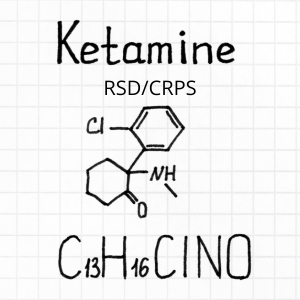Ketamine is an anti-inflammatory medication that has the potential to dramatically reduce the pain you experience from your complex regional pain syndrome or reflex sympathetic dystrophy. Because of how it acts on your brain it also has the potential to relieve symptoms of post-traumatic stress disorder and depression, both of which you can develop as a result of your chronic and severe pain conditions, according to Dr. Nancy Sajben, a pain management specialist.
Opioid-based medications work best on acute pain, but they are not as effective for your chronic pain. A medication that reduces the need for opioid medications is needed. Because your pain comes with many symptoms (dystrophy and motor symptoms, sensory and autonomic pain that worsen with time), your condition actually alters your brain activity within the NMDA receptors. This makes your pain worse. Ketamine works by manipulating the NMDA receptors, stopping your symptoms.
 Knowing how ketamine works, what are the controversies around it?
Knowing how ketamine works, what are the controversies around it?
First, this medication has some psychotropic properties, including causing hallucinations (ketamine intoxication). Taking a benzodiazepine can reduce the hallucinogenic effects.
One term for its dissociative effects is “K-hole,” which means users experience a distortion in bodily awareness, causing them to feel as if they are flying or gliding on silk. Once they come out of ketamine’s effects, they reintegrate slowly. They find body movement difficult, probably because they might not be aware they have a body. These side effects have led medical professionals to rely less on ketamine for human use. Because of the risk for illicit use, in 1999, ketamine was placed on Schedule III of the United States Controlled Substance Act. Recreational users have made ketamine popular for use at raves – its street name is “Special K.”
Ketamine has less of an effect on the respiratory system than to other anesthetic medications. Instead, it actually stimulates the circulatory system. As a strong analgesic, this medication can be used in sub-anesthetic doses to relieve acute pain.
What this means for you is that this medication can effectively treat your CRPS and RDS pain, using low doses. Low-dose therapy is safe, but you may experience some side effects, including dizziness, lightheadedness, nausea and hallucinations. For this reason, the medication should only be administered when a trained physician is available should any potential adverse effects develop. If this is a therapy you want to consider, but you are concerned about the hallucinogenic side effects, your doctor can also prescribe a benzodiazepine sedative to help control or avoid hallucinations.
When ketamine is found to be an effective treatment for your CRPS or RDS, it is administered either as an intramuscular injection or intravenously. It can also be used in smaller doses (0.1 to 0.5 mg/kg/h) to locally anesthetize pain-associated movement as well as neuropathic pain.
Your doctor may choose one of two treatment modalities, once he determines that treatment of your pain condition with ketamine is a viable medical treatment for you.
√ Treatment 1:
Your doctor can admit you to the hospital, either on an outpatient or inpatient basis. Using what is called the “awake technique,” he infuses a low dose of ketamine – between 25 and 90 mg of ketamine per day, in a five day treatment regimen. In a 10-day medical infusion of ketamine, one patient received a four-hour ketamine infusion that escalated from 40 to 80 mg and responded with a significant reduction of pain. This patient also regained some mobility.
√ Treatment 2:
In the second modality, your doctor admits you to the hospital and puts you into a medically induced coma. You then receive an extremely high dose of ketamine – between 600 and 900 mg. This treatment is not allowed in the U.S. It is more common in Germany and Monterrey, Mexico. While the original injury is not cured, the resulting CRPS or RSD are, in effect, cured or placed into remission. Patients who were wearing morphine pumps are able to have them surgically removed. A patient in Tuebingen, Germany, a patient with CRPS stemming from a wrist injury underwent the medical coma treatment. Her ketamine doses were increased by 3 to 5 mg/kg/hr per day, in conjunction with midazolam over five days. Her swelling and skin discoloration disappeared on the second day. She began moving her right arm spontaneously. On the sixth day, her CRPS symptoms were completely resolved and her ketamine infusions were tapered down. Eight years after her treatment, she has stayed in complete remission. Because of the high dosage of ketamine, she did experience psychiatric side effects, which were managed with the midazolam. These effects resolved themselves within one month of her hospitalization and treatment, according to the Bionity website.
(Ketamine is now available in a metered nasal sprayer, allowing you to deliver a low dose of medication nasally. This makes it easier for you to manage your pain symptoms without having to drive to a pain specialist’s office, undergo IV or intramuscular injections.)
Ketamine’s Psychological Side Effects
In low doses, ketamine causes few to no side effects in adults. If you do take a low dose of ketamine and you experience any side effects, they are temporary and vanish within 20 minutes. Those patients who experience side effects say they are mild and the pain relief is more important than the discomfort of the side effects.
Side effects can include short-term hallucinations. If you experience a hallucination with a low dose of ketamine, you may only see its effects in a dark room when your eyes are closed. If you are using higher doses (medium to high), your side effects are more intense.
Another Beneficial Effect of Ketamine
Your RDS or CRPS may have led to symptoms of depression or PTSD. A low dose of ketamine, taken via a nasal inhaler, can treat your CRPS or PSD pain and symptoms of major depression, according to Dr. Nancy Sajben.
References: Ketamine Intranasal for Rapid Relief of Pain and Depression (http://painsandiego.com/tag/ketamine/); Ketamine (http://human.freescience.org/htmx/ketamine.php); Ketamine (http://www.bionity.com/en/encyclopedia/Ketamine.html)
